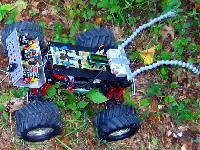Ticks beware: RC Truck Hacked for Pest Control

 Ticks are a health hazard to humans and pets alike. Yet few spray pesticides indiscriminately in tick-infested areas, primarily out of concerns over environment and cost.
Ticks are a health hazard to humans and pets alike. Yet few spray pesticides indiscriminately in tick-infested areas, primarily out of concerns over environment and cost. Justin Woulfe and his fellow students at the Virginia Military Institute came up with a novel solution. They hacked an RC truck, upgraded the drive motor to 11W, the batteries to 12V NiMH, and added an Atmel AVR ATmega8. The resulting robot, dubbed Tick Rover, was then sent out to comb the lawn.
The ticks that jumped onto the comb and were exposed to localized Permethrin, zapping the insect without leaving any chemicals behind. Environmentally it is much safer. But what about the cost?
At $500 a pop, Woulfe doesn't expect consumers to purchase the machine. But pesticide companies who invest in it could charge less for running the robot -- about $75 per acre -- than they now charge for spraying, which costs about $85 per yard.
Not too bad for a first generation prototype. The IEEE thought so, too, and rewarded the effort.
The students earned an undergraduate research grant to fund development, and wrote a paper on the device which won first place in the Virginia Mountain Section of the annual IEEE Student Papers Contest, and then won second place in the IEEE Region 3 contest -- one of the 6 regions in the country.
For more information, see the first and second field test results, Woulfe's paper, and this article on Wired.
Thanks for helping to keep our community civil!
Notify staff privately
You flagged this as spam. Undo flag.Flag Post
It's Spam
This post is an advertisement, or vandalism. It is not useful or relevant to the current topic.
This post is an advertisement, or vandalism. It is not useful or relevant to the current topic.
You flagged this as spam. Undo flag.Flag Post


